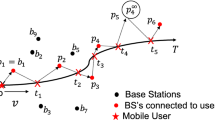Abstract
Classical micro-mobility solutions focus on accelerating local handovers and on minimizing signalling traffic. However, the micro-mobility components also slow down the service times in the user traffic domain. This is a critical drawback in terms of the hard delay requirements of future IP-based radio access networks. Network operators need algorithms to determine the optimal number and placement of anchor points within his network to balance both handover latency and user traffic delay.
This paper presents a very fast and exact mathematical method for selecting the optimal number and placement of nodes supporting micro-mobility functionality for telecommunication networks. The method is in particular applicable for large networks, which is demonstrated by means of an optimization of a real wireless access network with more than 150 nodes. In order to ensure the applicability in real network scenarios we additionally provide a solution to estimate the stability of the optimal configuration. The presented method allows the autonomous and optimal configuration of the network’s micro-mobility functionality as described in concepts of zero-touch networks. Due to the optimization network operators can reduce the administration cost and maximize the quality of service as well.
Access this chapter
Tax calculation will be finalised at checkout
Purchases are for personal use only
Preview
Unable to display preview. Download preview PDF.
Similar content being viewed by others
References
Reinbold, P., Bonaventure, O.: IP Micro-mobility Protocols. IEEE Communications Surveys and Tutorials 5 (2003), http://www.comsoc.org/livepubs/surveys/public/2003/sep/reinbold.html
Kar, C.A., Christos, P., Rahim, T.: Performance Evaluation of Mico-mobility Protocols for All-IP Based Infrastructures. Wireless World Research Forum (December 2002)
Robert, H., Aruna, S., Hesham, S., Karim, E.-M.: Performance analysis on Hierarchical Mobile IPv6 with Fast-handoffoverEnd-to-End TCP. In: GLOBECOM, Taipei, Taiwan (2002)
Eva, G., Annika, J., Charles, P.E.: Mobile IP Regional Registration. draft-ietf-mobileip-reg-tunnel-04.txt, Internet Draft, Internet Engineering Task Force (2000)
René, B., Ahmad, S., Ali, D., Andreas, M.-T., Matthias, S.: I-MPLS: A Transparent Mico-Mobility-enabled MPLS Framework. In: 11th European Wireless 2005, Cyprus (April 2005)
Hesham, S., Claude, C., Karim, M.E., Ludovic, B.: Hierarchical Mobile IPv6 mobility management. Network Working Group Draft (2004), draft-ietf-mipshop-hmipv6-04.txt
Craig, C.W., Steven, H., David, L.X.W.: High Density Model for Server Allocation and Placement. ACM Sigmetrics (2002)
Mark, D.S.: Network and Discrete Location: Models, Algorithms, and Applications. John Wiley & Sons Inc., New York (1995)
Eiselt, H.A., Sandblom, C.-L.: Integer Programming and Network Models. Springer, Heidelberg (2000)
MathWorks: Matlab 7 Online Help (2004)
Author information
Authors and Affiliations
Editor information
Editors and Affiliations
Rights and permissions
Copyright information
© 2006 Springer-Verlag Berlin Heidelberg
About this paper
Cite this paper
Liers, F., Böringer, R., Mitschele-Thiel, A. (2006). Optimal Placement of Anchor Points Within Large Telecommunication Networks. In: Braun, T., Carle, G., Fahmy, S., Koucheryavy, Y. (eds) Wired/Wireless Internet Communications. WWIC 2006. Lecture Notes in Computer Science, vol 3970. Springer, Berlin, Heidelberg. https://doi.org/10.1007/11750390_9
Download citation
DOI: https://doi.org/10.1007/11750390_9
Publisher Name: Springer, Berlin, Heidelberg
Print ISBN: 978-3-540-34023-2
Online ISBN: 978-3-540-34024-9
eBook Packages: Computer ScienceComputer Science (R0)




